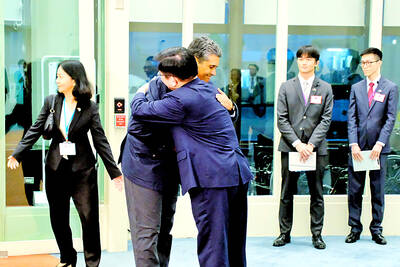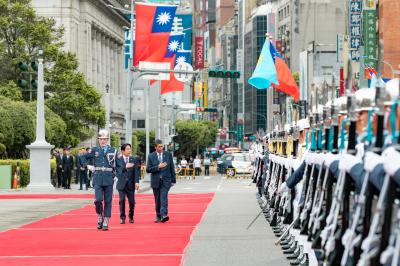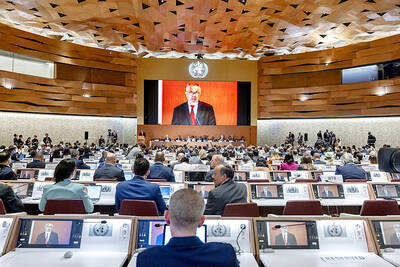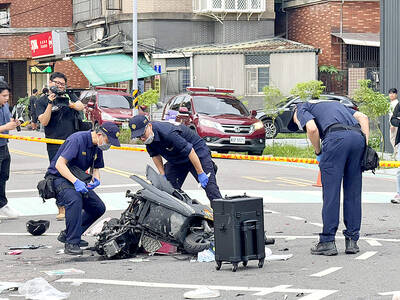The Republic of China (ROC) on Taiwan is a different country from the one founded in China in 1912, despite having the same name, Vice President Annette Lu (呂秀蓮) said yesterday.
Arguing that it is the status quo today that "the ROC is Taiwan, and Taiwan equals the ROC, " Lu said the issue of whether the country's official name should be Taiwan or the ROC is a matter that the people in this country can take their time to deal with in the future.
Lu made the remarks in a speech on Taiwan's international status at Tamkang University.
Lu said that China cut its ties with Taiwan when it ceded Taiwan and Penghu to Japan in 1895.
Although the Cairo Declaration of 1943 called for Japan to return the territories to the ROC, the document did not bear the signatures of the leaders of the ROC, the US and the UK who attended the conference and therefore cannot be considered an official treaty, Lu said.
At the time of the signing of the San Francisco Peace Treaty in 1951, the world had not decided upon whether Japan should sign a peace deal with the ROC government in Taiwan or with the People's Republic of China government, Lu said, noting that Japan opted to sign the treaty with the ROC government.
"Both the Cairo Declaration and the Treaty of Peace Between Japan and China show that the Taiwan issue is totally unrelated to the Beijing government. Taiwan is definitely not part of China as claimed by Beijing," Lu said.
According to Lu, the history of the ROC can be divided into four phases, with the first lasting from the republic's founding in 1912 to its 1949 defeat in China's civil war.
The second began in 1950 after ROC president Chiang Kai-shek (蔣介石) moved the capital to Taipei, Lu said.
The third phase began in 1991 when then President Lee Teng-hui (
The fourth phase, Lu said, began in 1996 when the people of Taiwan were allowed to directly elect their president for the first time.

Palauan President Surangel Whipps Jr arrived in Taiwan last night to kick off his first visit to the country since beginning his second term earlier this year. After arriving at Taoyuan International Airport at around 6:30 pm, Whipps and his delegation were welcomed by Minister of Foreign Affairs Lin Chia-lung (林佳龍). Speaking to gathered media, the Palauan leader said he was excited and honored to be back in Taiwan on his first state visit to Taiwan since he was sworn in this January. Among those traveling with Whipps is Minister of State Gustav N. Aitaro, Public Infrastructure

President William Lai (賴清德) yesterday thanked Palau for its continued support of Taiwan's international participation, as Taipei was once again excluded from the World Health Assembly (WHA) currently taking place in Switzerland. "Palau has never stopped voicing support for Taiwan" in the UN General Assembly, the WHO and other UN-affiliated agencies, Lai said during a bilateral meeting with visiting Palau President Surangel Whipps Jr. "We have been profoundly touched by these endorsements," Lai said, praising the Pacific island nation's firm support as "courageous." Lai's remarks came as Taiwan was excluded for the ninth consecutive year from the WHA, which is being held in

RESOLUTIONS DEBATE: Taiwan’s allies said that UN and WHA resolutions cited by China and other nations ‘do not determine Taiwan’s participation in WHO activities’ A proposal to invite Taiwan to this year’s World Health Assembly (WHA) was rejected on Monday, resulting in Taipei’s absence from the annual meeting for a ninth consecutive year, although partners spoke up for Taiwan’s participation at the first day of the meeting. The first agenda item after the opening was a “two-on-two debate” on a proposal to invite Taiwan to participate at the WHA as an observer. Similar to previous years, two countries made statements in favor of the proposal, while two others expressed their opposition. Philippine Secretary of Health Teodoro Herbosa, president of the 78th WHA, accepted the WHA General Committee’s

At least three people died and more than a dozen were injured yesterday afternoon when a vehicle struck a group of pedestrians in New Taipei City’s Sansia District (三峽). The incident happened at about 4pm when a car rammed into pedestrians at an intersection near Bei Da Elementary School. Witnesses said the sedan, being driven at a high speed, ran a red light, knocking scooters out of the way and hitting students crossing the road before careening into a median near the intersection of Guocheng and Guoguang streets. The incident resulted in three deaths and 13 injuries, including the driver, a 78-year-old man